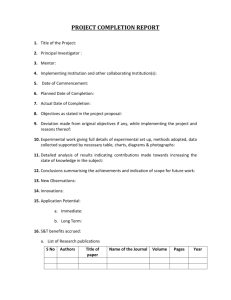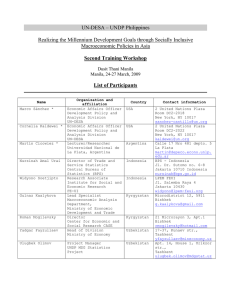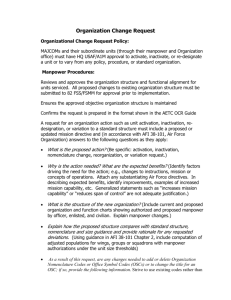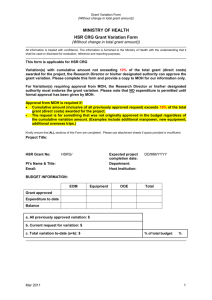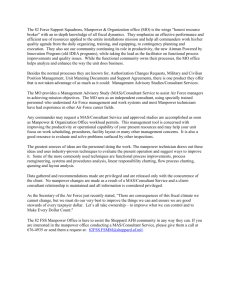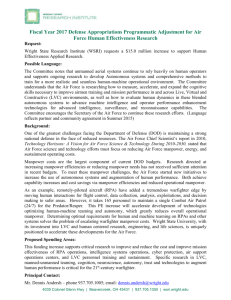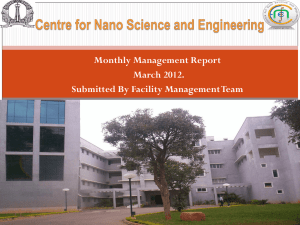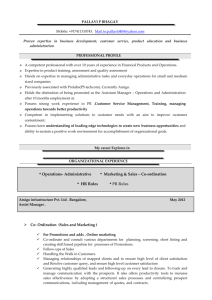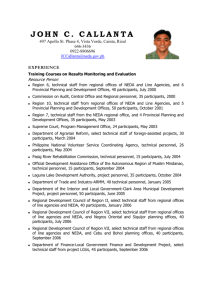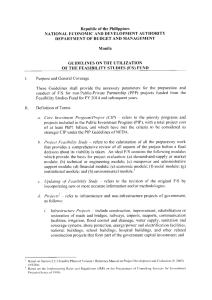program/project identification
advertisement
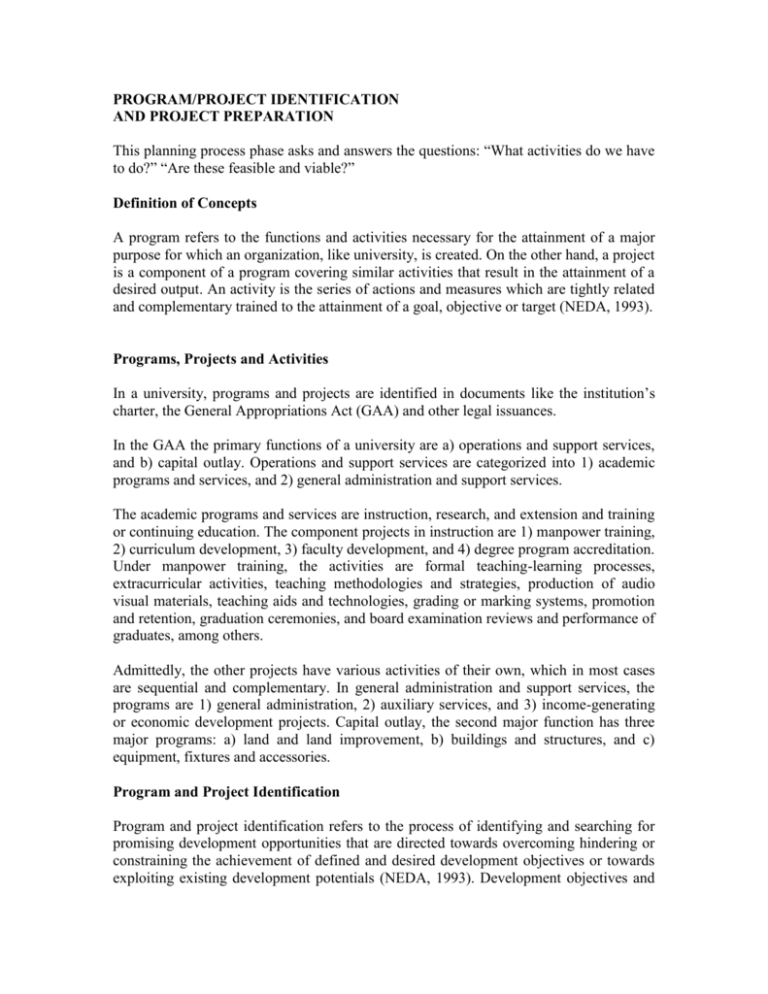
PROGRAM/PROJECT IDENTIFICATION AND PROJECT PREPARATION This planning process phase asks and answers the questions: “What activities do we have to do?” “Are these feasible and viable?” Definition of Concepts A program refers to the functions and activities necessary for the attainment of a major purpose for which an organization, like university, is created. On the other hand, a project is a component of a program covering similar activities that result in the attainment of a desired output. An activity is the series of actions and measures which are tightly related and complementary trained to the attainment of a goal, objective or target (NEDA, 1993). Programs, Projects and Activities In a university, programs and projects are identified in documents like the institution’s charter, the General Appropriations Act (GAA) and other legal issuances. In the GAA the primary functions of a university are a) operations and support services, and b) capital outlay. Operations and support services are categorized into 1) academic programs and services, and 2) general administration and support services. The academic programs and services are instruction, research, and extension and training or continuing education. The component projects in instruction are 1) manpower training, 2) curriculum development, 3) faculty development, and 4) degree program accreditation. Under manpower training, the activities are formal teaching-learning processes, extracurricular activities, teaching methodologies and strategies, production of audio visual materials, teaching aids and technologies, grading or marking systems, promotion and retention, graduation ceremonies, and board examination reviews and performance of graduates, among others. Admittedly, the other projects have various activities of their own, which in most cases are sequential and complementary. In general administration and support services, the programs are 1) general administration, 2) auxiliary services, and 3) income-generating or economic development projects. Capital outlay, the second major function has three major programs: a) land and land improvement, b) buildings and structures, and c) equipment, fixtures and accessories. Program and Project Identification Program and project identification refers to the process of identifying and searching for promising development opportunities that are directed towards overcoming hindering or constraining the achievement of defined and desired development objectives or towards exploiting existing development potentials (NEDA, 1993). Development objectives and growth potentials may be derived from national or regional development plans, sector surveys, industry studies, technical packages, multi-lateral or bilateral priorities and many other sources. Phases of program and project identification Projects identified should be supportive of institutional development thrusts, goals and objectives. In this connection, it is imperative for the leadership of the university to promote, establish and sustain a network of linkages with other government agencies, private foundations, business and industry, and other civic and social organizations. Program and project identification has two phases, namely (NEDA): environmental scanning process; and screening process. Environmental scanning process involves acquiring information about the events and relationships in the organization’s external environment, knowledge of which would assist top management in its task of directing the university’s course of action. Screening process assesses the output of the first phase and identifies specific opportunities which are in accordance with government priorities and meet other considerations such as growth potentials, competitive advantages, and subjective preferences relative to government regulations and resources uncertainties and limitations. The following steps are involved in the screening process: 1. Determination of requirements or needs in the traditional area of service of the organization; 2. Determination of growth objectives and contribution to nation building; 3. Evaluation of barriers to entry. An opportunity is unattractive if it has barriers to entry which the organization could overcome but would be difficult for others to overcome; and 4. Consideration of subjective preferences or attitudes to risk as well as the organization’s contribution to development. The risk factor may be expressed in governmental regulations, technical uncertainty, and social acceptability. Components of Program and Project Identification Once the environmental scanning and screening processes are completed, the next step the planner has to do is to consider the five components of program and project identification developed by NEDA, 1993. These are 1) identification of essential development problem, 2) identification of resources, 3) identification of projects and policies, 4) formulation of strategies, and 5) setting of targets and strategies. 1. Identification of essential development problem a. What are the essential current and future development needs and want of the people, current and future? Examples of development projects in the different sectors are presented to emphasize the growth potential of an academic institution in the country’s development effort. a.1 Social Sector Sub-sector: Education and Manpower Development Area of Concern: Information and Communications Technology Problem/Barriers: Lack of technical manpower Possible Project: Curriculum Development on Computer Science or Computer Engineering a.2 Economic Sector Sub-sector: Agriculture Area of Concern: Palay Production, Handling and Processing Problem/Barriers: Low production due to wastage Possible Project: Post Harvest Handling and Processing Technology a.3 Infrastructure Sector Area of Concern: Low production due to lack of irrigation system Problems/Barriers: Lack of irrigation system Possible Project: Improvement and construction of irrigation system a.4 Political Sector Sub-sector: Institution and Capability Building Problems/Barriers: Weak and pathetic government officials and employees Possible Project: Training and reorientation of government officials and employees b. What are the indicators or benchmarks to determine whether and to what extent problems exist? b.1 b.2 b.3 b.4 Social Sector: Dearth of technical manpower in computer and communications technology Economic Sector: Low productivity Infrastructure Sector: Low hectarage yield Political Sector: Waste of resources and excessive red tape c. Who are the interest groups affected? How do they view the problems? What weights of values do they attach to the problems? c.1 What are the implications if nothing is done to solve the problems aforecited? 2. Identification of resources What resources are available or can be tapped to solve the identified problem? How can the resources and the problem be reconciled? 3. Identification of projects and policies Given the range of essential problems, on the other hand, and the resources that may be exploited for development, on the other, what are the potential or likely feasible projects and policy measures that can be considered to resolved the problems? 4. Formulation of strategies This involves the determination of methodologies and strategies as well as priorities and phases in the pursuit of said development project. 5. Setting of targets and strategies This calls for the formulation of targets and objectives which should be simple, measurable, achievable, realistic, and time-bound. Project Preparation Once a project is identified, the next step would be project preparation. This stage essentially involves the conduct of feasibility study for the purpose of determining whether the project can and should be undertaken and if so, how and when. Project preparation is an investigation which determines the technical soundness, financial viability, economic desirability and operational feasibility of a project (NEDA, 2000). Its real objective is to guide project proponents, business managers and financial executives in determining the actions they must take on a project in order to bring about its successful operation. Project feasibility preparation and management is a broad topic which is covered by another subject (RD 703/ED 750).
